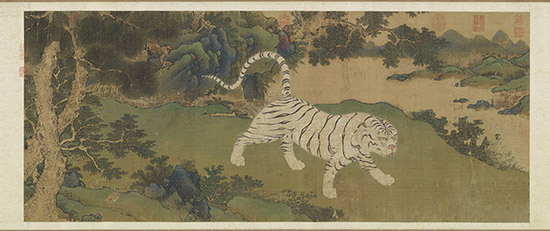明
卷 絹本設色
Ming dynasty
Hand scroll, ink and colors on silk
51.8cm (H) x 124.8cm (W)(每幅 each)
永樂二年(1404年)秋,傳言周王朱橚封邑內,神后山一帶有騶虞出現。朱橚捕獲,獻予明成祖。本幅畫就是描繪得自神后山的騶虞。騶虞是種罕見的白虎,身有黑紋,不食生物,被譽為有至信之德的義獸,故其現身為祥瑞之兆,象徵在位者有仁信之德。卷中山水色澤妍麗,部分使用泥金勾勒;繁密松針,植物花卉點綴吉祥瑞鳥,畫面精緻,應是永樂朝宮廷畫家所作。
According to a legend, in the fall of 1404, a tsou-yü appeared in the fief of the Duke of Chou (Chu Su) near the Shen-hou Mountain. Chu Su captured the precious animal and presented it to the Ming emperor Ch’eng-tsu. This painting depicts the tsou-yü from the Shen-hou Mountain, a variety of rarely seen white tigers striped with black, and is believed to be a beast of righteousness who eats no living beings, and its virtue is said to be faith. Therefore, if a tsou-yü appears, it is a good omen of great importance, heralding the reign of a benevolent and faithful emperor. In this handscroll, the colors are beautiful with some outlines painted with gold ink. The dense pine needles with plants and flowers are accompanied by auspicious birds. This refined painting is probably the work of a court artist under the Yongle emperor in the early-15th century.



















